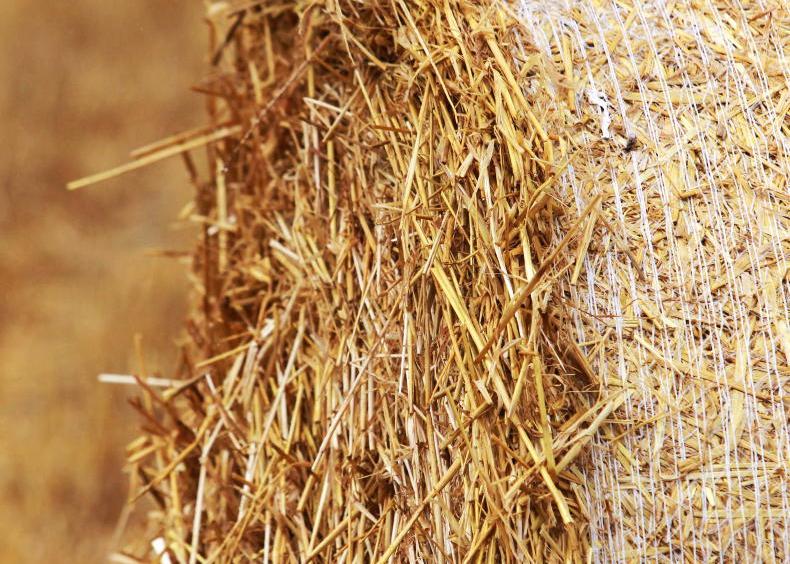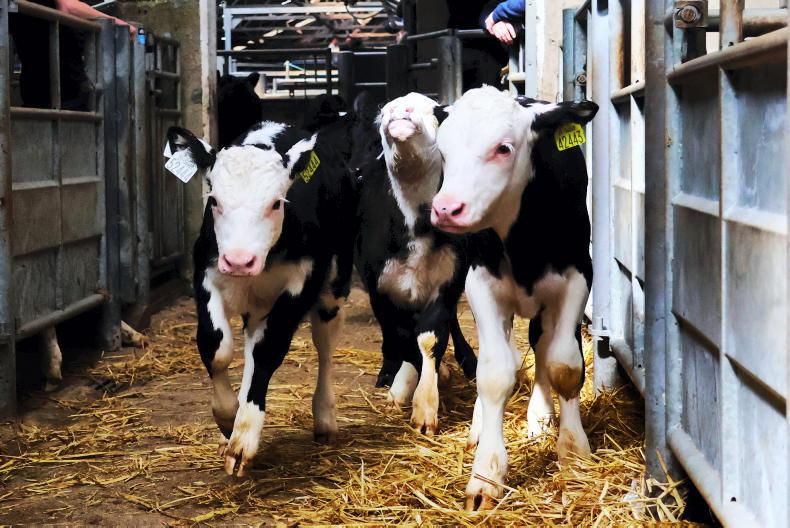Autumn-born calves should have access to a creep pen that offers a dry-bedded lying area, as should spring-born calves still suckling the cow.
Calves should not have to compete with cows for lying space. When forced to lie on wet, soiled bedding or concrete slats, calves have to burn more energy to maintain core body temperature.
When calves struggle to maintain body temperature, they become more susceptible to disease. Outlined are five tips to managing the calf creep during winter.
1. Bedding
Straw tends is the dominant choice of bedding in creep pens, but woodchip also works well and offers good insulation as well as soakage.
However, it is not suitable for spreading on grassland the following year. Woodchip needs to be ploughed back into ground, so it works well with conventional reseeding or cropping.
Regardless of bedding choice, make sure to keep it topped up regularly so calves have dry lying areas. If you kneel on the bed and feel the damp, then clean bedding needs to be applied.
2. Fodder
Offer calves some form of fodder in the creep pen, either high dry matter silage or good quality hay to stimulate rumen development in young calves and increase forage intake.
High dry matter fodder will keep the calves' dung firm, reducing the rate that bedding is soiled.
If calves have to compete with cows at the main feed barrier for fresh silage, they will be bullied and the risk of injury will become higher.
Offering fodder in the creep pen removes that risk and let calves eat fresh forage as soon as it is fed out.
3. Meal
Meal should also be offered in the creep pen. It may take a day or two for calves to catch on to the routine, but they quickly learn to enter the creep area when meal is offered.
If calves don’t come forward for meal, there is a strong chance that they are in the early stages of illness, so take action immediately.
4. Adjustable railings on the creep gate
If calves access the creep area via a gate, it should have adjustable bars to control animals moving in and out of the pen.
When feeding meal, the bar can be adjusted to allow younger, smaller calves into the pen first to eat. The bars can be opened to allow bigger calves in after a short period, cutting down on bullying.
In autumn-calving herds, calves can be locked in the creep during the day and overnight, with access to suck the cow for a couple of hours morning and night. This will improve heat activity.
5. Lighting and airflow
The creep pen should be well-lit by natural light or LEDs to monitor calves closely. Creep pens should be well-ventilated to provide fresh air, but just make sure that air inlets do not create a draught.
Read more
Beef Trends: big drop in bullock kill
Department hits pause on farm payments
Autumn-born calves should have access to a creep pen that offers a dry-bedded lying area, as should spring-born calves still suckling the cow.
Calves should not have to compete with cows for lying space. When forced to lie on wet, soiled bedding or concrete slats, calves have to burn more energy to maintain core body temperature.
When calves struggle to maintain body temperature, they become more susceptible to disease. Outlined are five tips to managing the calf creep during winter.
1. Bedding
Straw tends is the dominant choice of bedding in creep pens, but woodchip also works well and offers good insulation as well as soakage.
However, it is not suitable for spreading on grassland the following year. Woodchip needs to be ploughed back into ground, so it works well with conventional reseeding or cropping.
Regardless of bedding choice, make sure to keep it topped up regularly so calves have dry lying areas. If you kneel on the bed and feel the damp, then clean bedding needs to be applied.
2. Fodder
Offer calves some form of fodder in the creep pen, either high dry matter silage or good quality hay to stimulate rumen development in young calves and increase forage intake.
High dry matter fodder will keep the calves' dung firm, reducing the rate that bedding is soiled.
If calves have to compete with cows at the main feed barrier for fresh silage, they will be bullied and the risk of injury will become higher.
Offering fodder in the creep pen removes that risk and let calves eat fresh forage as soon as it is fed out.
3. Meal
Meal should also be offered in the creep pen. It may take a day or two for calves to catch on to the routine, but they quickly learn to enter the creep area when meal is offered.
If calves don’t come forward for meal, there is a strong chance that they are in the early stages of illness, so take action immediately.
4. Adjustable railings on the creep gate
If calves access the creep area via a gate, it should have adjustable bars to control animals moving in and out of the pen.
When feeding meal, the bar can be adjusted to allow younger, smaller calves into the pen first to eat. The bars can be opened to allow bigger calves in after a short period, cutting down on bullying.
In autumn-calving herds, calves can be locked in the creep during the day and overnight, with access to suck the cow for a couple of hours morning and night. This will improve heat activity.
5. Lighting and airflow
The creep pen should be well-lit by natural light or LEDs to monitor calves closely. Creep pens should be well-ventilated to provide fresh air, but just make sure that air inlets do not create a draught.
Read more
Beef Trends: big drop in bullock kill
Department hits pause on farm payments









SHARING OPTIONS